This post includes a decluttering checklist with over 100 ideas of what you can get rid of as a minimalist.
You’ll have a starting point for figuring out what to cut in each area of your life, from your wardrobe to your digital data. I’ve also created a free printable PDF version of the minimalism checklist for you to use — which you can find at the end of this article.
There’s a lot of ground to cover, so I won’t be going into specific details about how to discard these items responsibly. I suggest you read my guide on minimalist tips for decluttering to familiarise yourself with the destination piles, so you can get rid of your things while reducing your waste.
I hope that this list inspires and motivates you to minimise your things and enjoy a clutter-free environment. Let’s start with the living room.
Living room
Imagine walking into your living room and being greeted by a sense of peace and tranquillity. The space is open and airy, with plenty of room. Natural light streams through the windows, casting a warm glow on the clean surfaces and comfortable furnishings.
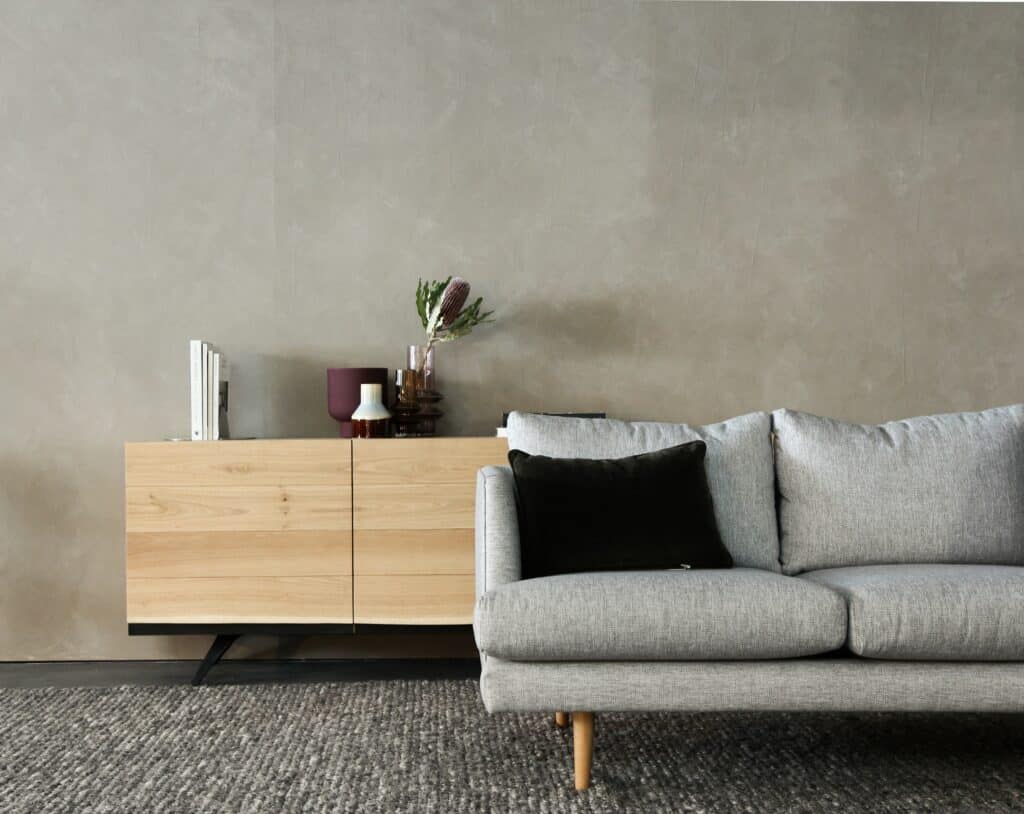
There are no piles of paper or stacks of books. Everything has its place, and there is a place for everything. This is a space that invites you to relax and unwind, where you can truly be yourself.
Here are some ideas of what you can minimise to fulfil that vision.
- Magazines and newspapers: If you don’t read your printed media, chances are, you won’t miss them either. This will free up valuable space in your home and give you one less thing to dust. If you’re worried about missing out on important news or articles, consider signing up for a digital subscription. That way, you can catch up on reading while decluttering your living room simultaneously.
- Word signs: Word signs are a popular decoration, but they can make a living room feel cramped and cluttered. Moreover, they can be difficult to dust and keep clean. If you’re looking to declutter your living room and free up some space, getting rid of word signs is a great place to start.
- Media units: Bulky media units take up valuable space, attract more clutter, and can be a tripping hazard. Alternatively, if you can, mount your TV on the wall. This will not only create valuable floor space, but it’ll also give your living room a more modern look.
- Old remotes: If your coffee table is cluttered with multiple remote controls (some old, flat or not working), it might be time to declutter. A minimalist approach is to invest in a universal remote control (you might already have one). Universal remotes are designed to work with various devices. So you can ditch those outdated controllers for good.
- Coffee table books: Coffee table books are often large and bulky, taking up valuable real estate on your coffee table. You open up space and give yourself more breathing room by decluttering them.
- Unplayed video games: If you have video games that you’ve never played (or no longer play), it’s time to let them go. Not only are they taking up space in your lounge room, but they’re also collecting dust. If you don’t think you’ll ever play them, donate them to a local charity or sell them online. You can make some extra cash while freeing up some space.
- Excess furniture: Unnecessary furniture pieces in your living room can create clutter and make the space feel smaller. This is why some minimalists go furniture-free. Consider how many people you typically have over and how much seating you need. If you rarely use some of the furniture in your living room, e.g. bean bags, it may be time to get rid of them. Another way to determine if you have too much furniture is to measure the size of your living room and compare it to the size of your furniture. If your furniture takes up more than half of the space in your living room, it’s time to scale back.
- Board games and puzzles: If you have a lot of board games and puzzles taking up space in your living room or you have missing pieces, it’s time to declutter them. These items often take up significant space, and they can also be annoying to dust and keep clean. Consider donating them to a local charity or selling them.
- DVDs, tapes and their players: This is for the Baby Boomers. Hanging onto your DVD and VHS collection slowly takes over your living room. You can find 95% of the content digitally. And for those rare sentimental films or old home videos, look into getting them converted into digital. Depending on the severity, this action alone will transform your living room.
- CDs, cassettes and their players: Like DVDs and VHS tapes, hanging onto your CD and cassette collection is outdated, so digitise them onto a hard drive. The only caveat may be vinyl and record players, as these aren’t as obsolete, but only if you use and enjoy them. If you don’t, it’s time to let go.
- Dead plants: If you have any plants in your living room that are dead or dying, it’s time to get rid of them or replace them. Not only are they taking up space, but they also look unsightly.
- Multiple TVs: The average number of TVs in an American home is 2.3. Which is 1.3 too many, especially considering how many computers, tablets and smartphones are at our fingertips. TVs are one of the quickest and easiest items to sell. If you have a few extra TVs lying around, put them up for sale and enjoy the extra space.
- Candles: If you have any candles burned down to the wick, you don’t like the smell, or you received them as an unwanted gift, it’s time to let them go.
- Throw pillows: If you have more throw pillows on your couch than people, it’s time to declutter. They create visual clutter but also become impractical when trying to sit on the couch.
- Wall décor: I’m not saying to get rid of all of your wall furnishings and artwork. But if you have a lot of pieces that are taking up space and you don’t adore, remove them. The same goes for all those rolled-up posters and décor sitting in storage for many years with no home.
- Souvenirs and knick-knacks: One of the most common sources of clutter is souvenirs and knick-knacks. We often keep these items because they hold sentimental value or remind us of happy memories. However, they can quickly become dust collectors and take up valuable space in our homes. Not to mention, they often don’t match the style of your living room. If you’re struggling, keep the most special ones in your sentimental box.
- Coasters: As coasters are small items, it’s easy to accumulate a lot of them over time. If you have coasters that you don’t use, are different from the rest, or are broken, remove them.
- Books you’ve never read: How often have you told yourself that you’ll read a particular book and then continue buying or borrowing other books instead? This goes on for years — but now is the time to let go and move on. If you’re not highly motivated to read the books, you’ll benefit more from the space.
Suggested Read => Minimalist Bookshelf Ideas
Bedroom
A clutter-free bedroom is a haven of peace and relaxation. It’s a space where you can go to unwind and escape the busyness of everyday life.
Every item in the room should have its own place, and there should be no clutter on surfaces or corners.
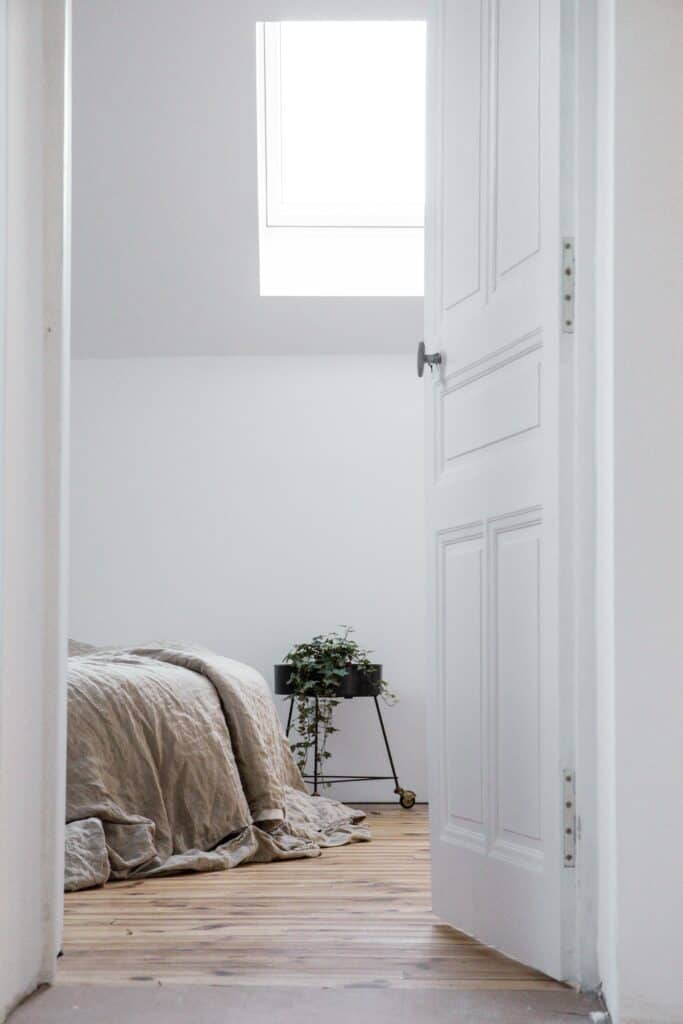
Creating this clutter-free zone will help you feel more organised, calm, and get a good night’s sleep. Below are some items you should consider adding to your decluttering checklist to create that unique environment.
- That random chair: If you have a spacious bedroom, it’s common to fall into the trap of adding a chair for decoration or extra storage. The problem is this chair becomes a rampant dumping ground for your clothes when you’re too lazy to put them away. You’re better off removing the chair and the temptation to produce clutter.
- Flat pillows: Poor pillows create sleep deprivation and neck problems. If you have more than 2 pillows on your bed, chances are you’re using the wrong type of pillow, or you’re sleeping in the wrong position. Consider removing some of your pillows to remove clutter and see if it makes a difference in how you sleep.
- Extra sheets: The truth is, you don’t need as many sheets as you might think. Two sets of sheets – one for use and one for washing – should be plenty. And when it’s time to wash them, you can simply pop them in the washing machine and put them back on the bed when they’re clean.
- Bedspreads: Bedspreads are often bulky, take up a lot of space, and don’t really serve many purposes. If you have one that you don’t use or that’s in bad condition, remove it.
- Photos/frames: Frames add visual interest to a room, but they can quickly become overwhelming if you have a lot of them. Consider removing some of your photos and frames to create a more streamlined look.
- Excess dressers/storage: A cluttered bedroom usually means there is too much furniture. Storage becomes our haven when we could probably do with less as a way to store fewer items. For example, replace your large dresser with an open clothing rack or shelves to declutter your bedroom and create more space — which brings us to the next section to declutter.
Closet
How wonderful would it be to know that everything in your wardrobe has a place and serves a purpose? To wake up each day feeling clutter-free and ready to take on the world?
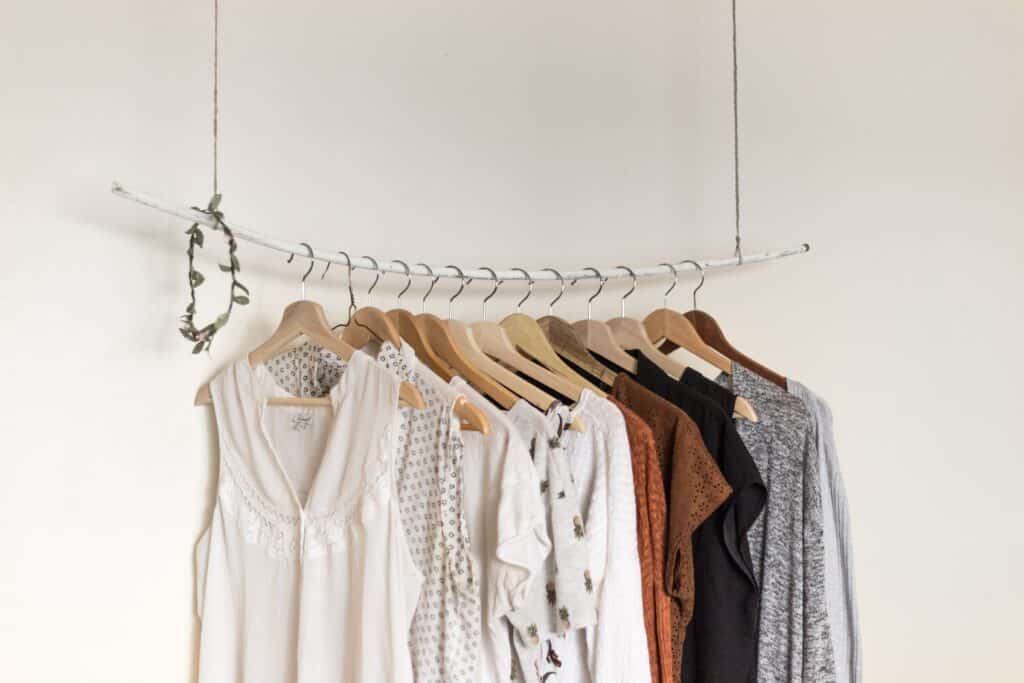
It might sound like a pipe dream, but it doesn’t have to be. Having a clutter-free living closet is possible with planning and forethought. Here’s what you should consider minimising:
- Clothing that doesn’t match your climate after moving: It can be tempting to hold on to clothing that no longer fits the weather. But you risk wading through a pile of clothes every time you want to get dressed. Instead, only keep the items that match your new climate.
- Missing pairs of clothing and jewellery: Most of us have a drawer (or two) full of incomplete pairs of clothing – single socks, unmatched gloves, single earrings and shoes without mates. These misfits take up valuable space and cause frustration when looking for a specific item. So next time you’re considering keeping that single sock “just in case,” remember the benefits of decluttering and let it go.
- Multiple sunglasses or prescription glasses: How many pairs of sunglasses do you need? How many prescription glasses do you have that you don’t use? You don’t need as many as you think. It’s time to pair down.
- Promotional clothing: Over time, you’ve probably accumulated free t-shirts, sweaters and singlets from various events and promotions. While it might be nice to have a collection of free clothes, this type of clutter creates more decisions in your day. They’re also unlikely to match your fashion style, creating unnecessary clutter.
- Extra buttons and strings: Your new clothes usually come with a few extra buttons and strings. While it might be tempting to toss them in your kit, they’ll be forgotten more often than not. One approach is to attach your extras to the clothes they belong to using a safety pin (I think — I’m not a seamstress). This will keep them together and make finding them when you need them easier.
- Stretched swimwear: You probably have that one swimsuit that you’ve been hanging onto for too long. The straps are stretched, the fabric is see-through, and it’s not flattering anymore. It’s time to let it go.
- Worn bras and underwear: Bras and underwear are essential clothing items, but that doesn’t mean you need a ton of them. You can get away with just a few bras and panties in different styles and colours. So next time you’re considering buying a new set, ask yourself if you need it. And like swimwear, bras and panties should be replaced when they start to stretch or lose their shape.
- One-off pieces: Old prom/formal dresses, bridesmaids’ dresses, tuxedos, and fancy costumes are all examples of one-off pieces. While it might be nice to have a few items for special occasions, these clothes often go unused and take up valuable space. If you don’t plan on wearing them soon, it’s best to declutter them. Plus, they’ve already served their purpose, and you can thank them for the memories on their way out the door.
- Inactive hobby clothing: You’ve probably envisioned yourself taking up skiing, tennis, rock climbing or another interest. Mine right now is Olympic lifting. These hobbies typically require special clothing and can drastically increase your wardrobe clutter when inactive. If you’re unlikely to pursue the hobby anytime soon, it’s best to sell the associated clothing.
- Uncomfortable shoes: We all have those shoes that we never wear, but we can’t seem to get rid of them because we paid good money for them. Furthermore, high heels, undersized sneakers, and super pointy dress boots can cause blisters and general discomfort. It’s time to let them go. If they’re still in good condition, sell them and put the money towards a new pair of shoes that you’ll wear.
- Unworn hats: Do you have a drawer full of hats that you never wear? You only need a few good-quality hats in different styles, so feel confident in minimising them. And like other items of clothing, caps should be replaced when they start to lose their shape or get old.
- Purses and bags: Ditch ultra-specific pieces that can only be worn with one outfit and choose more versatile bags that can be mixed and matched with different looks. In addition, decluttering your purses and handbags will free up space in your closet and make getting dressed in the morning a breeze. Oh, and don’t forget to declutter the contents in your bags. Remove anything that’s broken, worn, or you don’t need.
- Scarves: We tend to accumulate a disproportionate number of scarves compared to how many we regularly wear. Take a brief moment to decide which scarves are your favourites and which ones you can live without. The ones you don’t wear or don’t like as much can be donated to a charity or sold.
- Extra hangers: After decluttering so many things in your closet, you might find a surplus of hangers. If this is the case, get rid of them. Extra hangers just take up space and entice you to acquire more clothes than you need.
- Old jewellery and watches you don’t wear: We all have those pieces of jewellery that we never wear, but we just can’t seem to get rid of. Some you’ve received as a gift, others you’ve just outgrown, or perhaps it’s an expensive hobby. Whatever the case, it’s time to let them go. Sell them and put your money towards something you’ll genuinely use and value.
- Unrepariable clothing: This is the final category of clothing that you should declutter from your wardrobe. Clothing that is stained, ripped or has holes in it can’t be fixed and should be tossed. It’s time to say goodbye to those clothes you’ve been hanging onto for too long.
Also Read => Minimalist Wardrobe Tips & Checklists for Men & Women
Kitchen
Any cook will tell you that the kitchen is the heart of the home. It’s where we come together to create nourishing meals for our loved ones. But when our countertops are cluttered, it takes away from the joy of cooking.
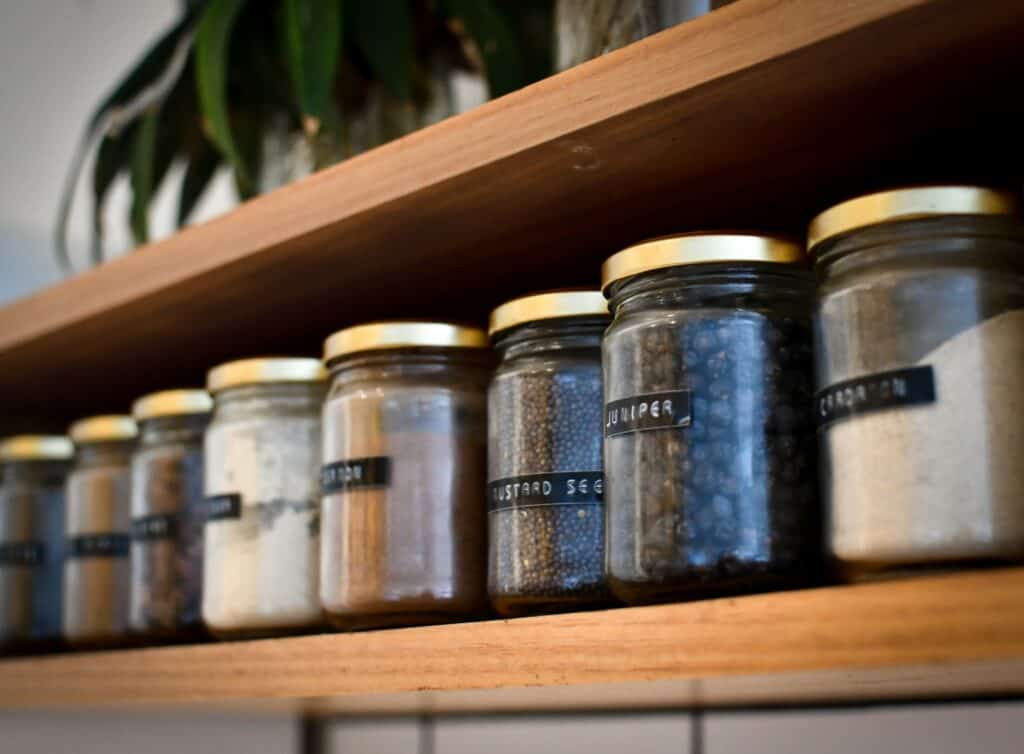
A clutter-free kitchen is also a safer kitchen, as it minimises the risk of accidents and makes it easier to keep the space clean. So if you’re ready to embrace a minimalist kitchen, below are some ideas on what to remove.
- Ultra-specific kitchen tools: One type of kitchen clutter that is particularly easy to accumulate is gadgets that serve only one specific purpose. For example, do you need a separate appliance for juicing, bread making, and pastry making? A good quality blender or food processor will do the trick in most cases. And if you don’t have either of those, a simple knife can do wonders.
- Too much cookware: Do you have five stockpots and four saucepans? If the answer is yes, it’s time to reduce. You probably only need 1 or 2 stockpots and 1 to 3 saucepans. The same goes for other types of cookware. If you only use a particular piece once or twice a year, it’s time to let it go.
- Duplicate cooking utensils: How many wooden spoons do you need? How about measuring cups, can openers, or cheese graters? You only need one of each.
- Fridge magnets: I get it. Fridges act as the community hub of a family home where everyone can keep tabs on important dates, chore lists and kid’s artwork. But when you remove all of those things, you appreciate the simplicity of space. When we became minimalists, fridge magnets were one of the first things to go, and we’ve been happier for it. If you can’t bear to part with your favorite magnets, store them in a box so they’re not taking up valuable space on your refrigerator.
- Awkwardly sized pots and pans: Do you have a pot or pan that’s so big it takes up half of your stovetop? Or one that’s so small it can only fit a single serving? It’s time to let go of the awkwardly sized cookery.
- Cheap or dull knives: Quality knives are essential to any kitchen. If your knives are dull, cheap, or just plain old, it’s time to upgrade. Dull knives are more dangerous than sharp ones, and they’re also harder to use. In saying that, if you can sharpen your knives, then there’s no need to replace them.
- Kitchen appliances you never use: If you have a food processor but never use it or an ice cream maker gathering dust in the back of your pantry, it’s time to declutter. Kitchen appliances can be super bulky and expensive, so there’s no point in keeping them if you’re not using them.
- Broken dishes: It’s rare to see a kitchen without chipped or damaged plates. We hang on to them because we think we might be able to fix them someday, but more often than not, they just sit in the cupboard, taking up space. Furthermore, broken ceramics are a safety hazard, so it’s best to eliminate them.
- Too many mugs and drinking glasses: Having too many cups and glasses can make it difficult to find what you need while making your kitchen feel cramped and cluttered. We (a household of two) only have 4 coffee mugs and 4 drinking glasses. This may seem like a small number, but it’s all we need to enjoy our morning cup of coffee and our evening glass of water and accommodate guests. And for wine lovers, a simple glass will do.
- Incomplete or mismatched storage containers: If you have a collection of storage containers, but they’re all different sizes and shapes, it can be challenging to find what you need when you need it. Not to mention, mismatched storage containers are not aesthetically pleasing. Find containers that are all the same size and shape to be stored together and discard the rest.
- Extra baking trays: Chances are, you have at least a few baking trays that are either the wrong size for your oven or that you mistakenly bought, thinking you’d use them differently. By minimising your baking trays, you can free up valuable space in your kitchen and make it easier to find a suitable tray for the job.
- Takeaway menus: Gone are the days of collecting takeaway menus and cluttering up your fridge doors and kitchen surfaces. There’s no need to keep those old takeaway menus with online menus and delivery services.
- Placemats: Do you have placemats that you never use? Or ones that don’t match your dining table? Placemats are a nice-to-have, not a need-to-have. If you can’t live without them, at least store them in a box or drawer so they’re not taking up valuable space on your dining table.
- Coupons: Like takeaway menus, coupons are a thing of the past. There’s no need to keep those old paper coupons with online shopping and discount codes.
- Unused spices: Do you have a cabinet full of herbs that you never use? Or ones that are so old they’ve lost their flavour? Get rid of those unused and expired spices and make room for the ones you use.
- Cookbooks: Though it can be challenging to let go of cookbooks, even if you haven’t used them in years, there are several good reasons. First, cookbooks take up valuable space in your kitchen, which could be better used for storing food or other kitchen supplies. Second, clutter can be distracting and overwhelming, making it harder to find the recipes you want to make. Finally, by decluttering your cookbooks, you can help make room for new cookbooks that you’re more likely to use. So if your cookbook collection is out of control, don’t be afraid to reduce and simplify.
- Expired food: We’ve all been guilty of hanging on to expired food, but it’s time to tack them head-on. Expired food is a safety hazard, and it can make your kitchen smell horrid. Get rid of expired food in your pantry, fridge, or freezer.
Bathroom
A clutter-free bathroom is an oasis for personal care. It’s a space that represents peace and relaxation, where you can take a moment to yourself to rejuvenate and recharge.

There should be nothing in the bathroom that causes you stress or anxiety. Below are some ideas of what you can declutter.
- Expired makeup, skincare, and haircare: The quickest win when decluttering your bathroom is to get rid of expired personal care products. These items take up valuable space. If you’re unsure when a product expires, check the back for a symbol that looks like a jar with an open lid and a number. It’s sometimes safe to use these products past expiry, but take it as an opportunity to move urgently.
- Threadbare towels: If your towels are starting to show signs of wear and tear, it’s probably time to move on. Threadbare towels are unsightly and less effective at absorbing water. Repurpose them as rags and invest in some new, high-quality towels.
- Duplicate brushes and combs: Do you have two of the same hairbrush? Or three combs that all serve the same purpose? You don’t need more than one brush or comb, so get rid of the extras and make more space in your bathroom.
- Personal care items that don’t work for you: Bathroom products require months, sometimes years, of trial and error. I bet you have makeup that’s the wrong shade, lotions you don’t like the smell of or hair gels that don’t vibe with your hair. Rather than holding onto the hope that you’ll one day find a use for them, declutter them and make more space in your bathroom.
- Worn tools: Perhaps the blade of your beard trimmer is getting blunt, or your makeup brush is frayed. Whatever the case may be, remove worn-out tools. You don’t want to use a blunt blade on your skin or a frayed brush on your delicate facial features.
- Travel-size toiletries or samples: At the time, you were thrilled to have scored bathroom samples from your holiday 3 years ago. But now, they’re just taking up space in your bathroom—time to go.
- Single-purpose items: Practising minimalism is finding ways to use fewer things. Looking at our minimalist bathroom, you’ll see how we’ve replaced single-purpose products with multipurpose products. For example, we use one bar of soap for our body and hair rather than two bars (one for each). This can be applied to other areas of your life, not just the bathroom.
- Duplicate or broken hair tools: It’s common to have duplicate hair tools, from hair straighteners to curling wands. Snuff out the copies and the broken ones. You don’t need two hair straighteners, and a broken curling wand is just eating up valuable storage.
- Empty products: These are items that you’ve used up but haven’t yet gotten around to throwing away. Using up products is satisfying and helps to keep your space tidy.
- Excess towels: Only you can decide how many towels you need. However, most of us have way more towels than we need. If you’re not sure which ones to discard, start with the ones that are old, worn, or never used. They could also be repurposed as rugs or floor mats.
Home office
A clutter-free home office is a space that inspires focus and productivity. It’s a calming oasis where you can go to get away from the noise and distractions of everyday life. The desk is clear of any clutter, with only the essentials within easy reach.
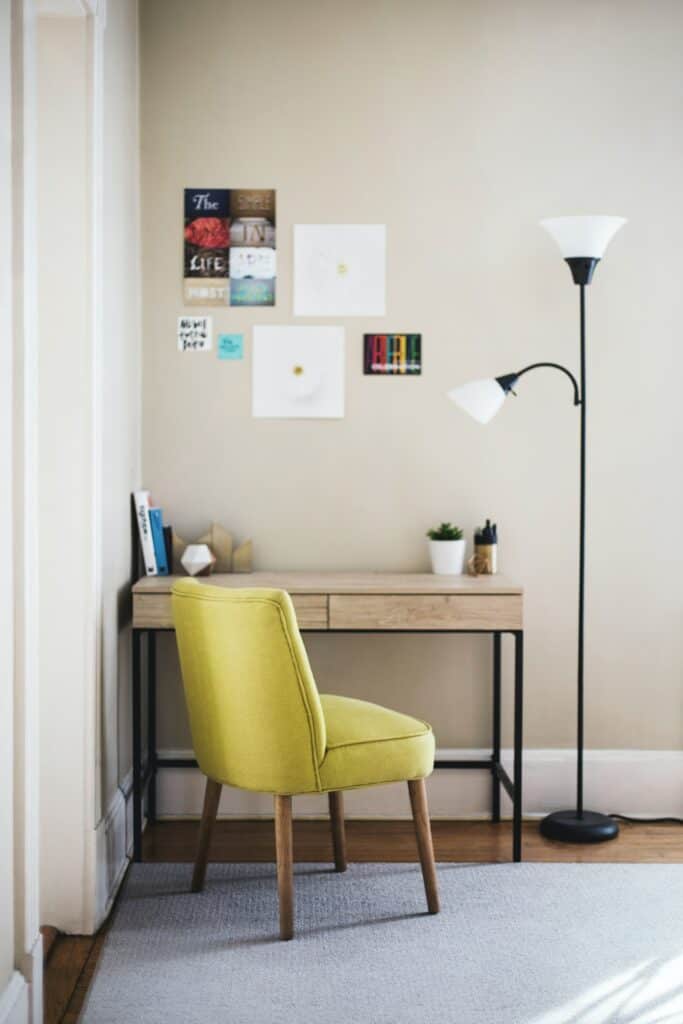
You can make a haven in this space where you can get work done and achieve your goals. Let’s look at some specific items you should consider decluttering in your study.
- Old receipts: Anyone who has ever tried to find a specific document in a mountain of paperwork knows it’s an absolute nightmare. It makes it hard to find what you’re looking for, but it also creates a feeling of overwhelm that’s paralysing. To regain some peace of mind is to digitise your old receipts. It’s much easier to organise digital files than physical ones. You’ll also be able to access your receipts from anywhere, whether at home or on the go.
- Broken and orphaned cords and cables: Cords and cables have a way of multiplying, and before you know it, they’re closing in on your study! They take up valuable space, but they can also be a safety hazard. Try to find a storage solution for all your cords and cables. This could be as simple as using a cable organiser or wrapping them around a binder clip.
- Pens and pencils that don’t work: Pens and pencils are among the most commonly misplaced items in the home office. Not only do they take up space, but they can also be a nuisance when you’re trying to get work done. Discard pens and pencils that have reached the end of their life, and find a storage solution for the ones still in good condition. This could be as simple as using a pen/pencil cup or a drawer organiser.
- Unused stationery: It’s easy to accumulate office supplies over time, but that doesn’t mean you need to keep them all. If you have clunky file folders or 4 staplers that you never use, it’s time to let them go.
- Boxes and mailers: It’s time to say goodbye to those old cardboard boxes and mailers. They’re taking up valuable space in your home office, but they’re also a waste of resources.
- Textbooks: Education has never been more fluid, and schools generally require students to purchase new versions of textbooks every couple of years. Meanwhile, you’re holding onto textbooks for years, making for outdated resources and collecting dust on your shelves. Discarding textbooks are the low hanging fruit to declutter on your bookshelf, so get rid of these first. Unfortunately, you probably won’t be able to sell or donate your textbooks, but at least you can plan to deal with them swiftly in the future if you decide to study again.
- Completed journals and notebooks: Firstly, well done for maximising the use of your journals. It’s a very satisfying feeling! Now that you’ve completed each page, they’ve fulfilled their purpose, so you can recycle them.
- Unused technology: Technology is expensive, and it’s easy to hang on to gadgets, hoping that you’ll find a use for it one day. But that day may never come. If you have old computers, scanners and printers that are no longer in action, it’s time to move on.
- Old business materials: Whether you’ve refreshed your company’s brand or moved on from your business entirely, you’re likely to have remnants of materials adding clutter to your home office. It’s time to recycle old business cards, posters, and other materials.
- Dead batteries: Don’t be that person who leaves flat batteries around the house. They’re adding no value whatsoever to your life. Recycle them and free up some space.
- Old calendars and planners: If you’re like most people, you probably have at least 1 old calendar or planner hanging around. While it’s tempting to hang on to them for sentimental reasons, they’ve served their purpose. Toss them in the recycling bin and make room for new memories.
Garage
The garage is one of the most versatile spaces in the home. It can be used for storage, a workshop, and parking space for your vehicles. Yet the garage notoriously ends up being a dumping ground for clutter. This makes it painful to find what you need when you need it, and it can also make your garage an unsafe place to work or park your car.
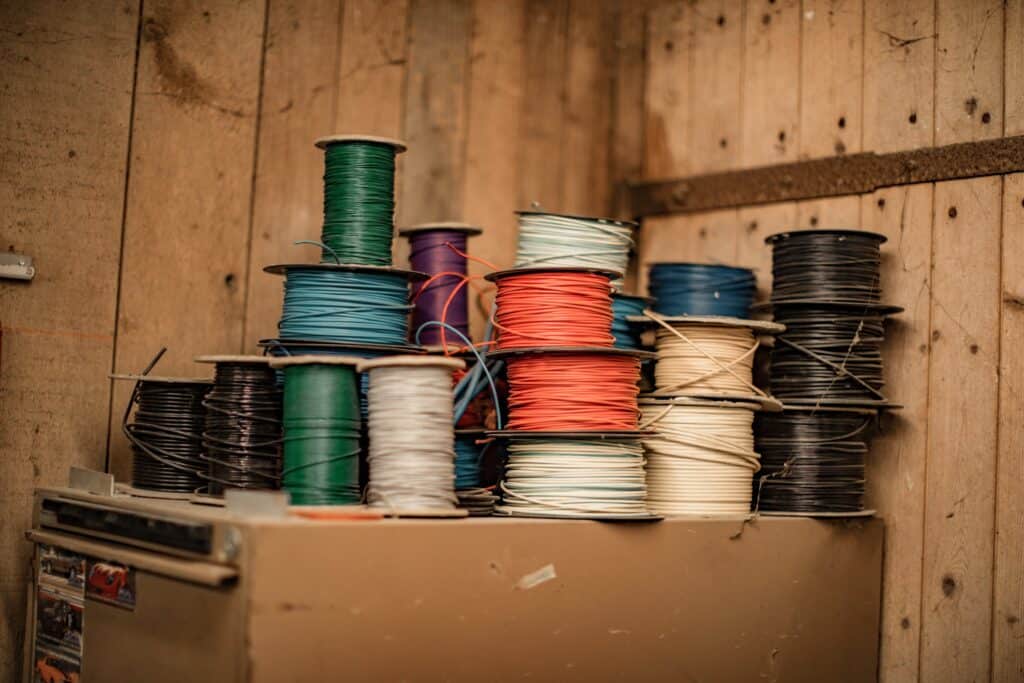
The solution is to strip your garage down to the essentials. Taking the time to organize and declutter your garage will make it more functional and efficient. Here’s the checklist:
- Unused plant pots: Sometimes our plants don’t make it despite our best intentions. If you have a graveyard of plant pots constantly reminding you of what you could be planting, it’s best to move on.
- Empty or old paint cans: Whether you’re an artist or a DIY enthusiast, chances are you’ve got some empty or ancient paint cans taking up space in your garage. That ship has sailed — discard.
- Lightbulbs: Dead lightbulbs have no business being in your garage. Recycle them today.
- Broken or unused tools: Tools are among the most commonly used items in the garage, so it’s important to keep them organised and in good condition. Declutter any leftovers.
- Furniture: Furniture can be a great way to add extra storage to your garage. But it can also be the start of significant levels of buried clutter. Out of sight, out of mind, right? No. Challenge yourself to reduce your garage storage and declutter the things inside your furniture. You can finally free up valuable space to park your vehicles with some luck.
- Hobby equipment: Items like camping gear, roller skates, and bicycles are all examples of hobby equipment that can quickly become clutter. If you’re not using them regularly, it might be time to let them go.
- Seasonal decorations: For hardcore minimalists, getting rid of seasonal decorations might be an easy decision. For instance, you can have an enjoyable Christmas without excessive decorations. Seasonal decorations can take up a lot of space, so it’s important to keep the ones you love and use. The key is to find a storage solution that works for you so that your decorations don’t take over your garage.
- Fitness equipment: Most of us start the year with good intentions to get in shape. But by the time we hit the mid-year point, that fitness equipment is often collecting dust in the garage. Furthermore, these treadmills, barbells, and obscure ab machines are cumbersome and awkward, making it difficult to find a place to store them. If they’re not being used, sell them.
Children’s things
Clutter doesn’t just affect adults; it can also have a negative impact on children. A clutter-free environment can help kids feel calmer, happier, and more focused. It can also provide them with more opportunities to play, learn, and explore.
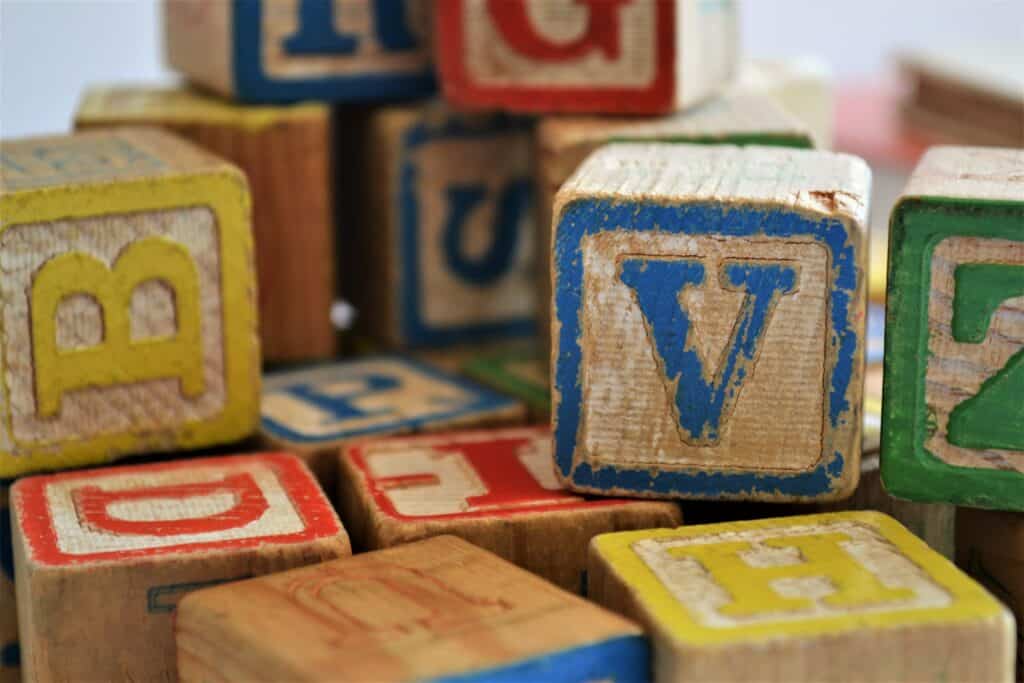
It takes a collective effort to enjoy aspects of minimalism as a family. So if you’re looking for ways to improve your child’s well-being, decluttering is a great place to start. Let’s look at some items to consider culling.
- Any clothing and furniture they’ve outgrown: As your kids grow, they’ll inevitably outgrow their clothing and furniture. If you’re hanging on to these items hoping that they’ll be able to use them again someday, it’s time to move on.
- Toys they no longer play with: We all have those unique, sentimental toys from childhood that we can’t bear to part with. But if your child is no longer engaged with the toys, there’s no point in keeping them. This also goes for inactive equipment, e.g. scooters, trampolines, skateboards etc.
- Books they’ve already read: It’s important to encourage your children to develop a love of reading. But once they’ve read a book (one or many times over), it’s okay to declutter them.
- Used up notebooks and colouring books: You want your kids to be creative. But once they’ve used up a notebook or colouring book, there’s no need to keep it.
- Old school projects: We all have fond memories of our school days. But hanging on to old school projects is just taking up space. If your child is done with an assignment, reflect on the learning and recycle it.
- Artwork: It’s natural to want to keep your child’s artwork. But it can quickly become overwhelming. If you’re hanging on to more than a few treasured pieces, it might be time to cull them.
Digital
In a world where we are constantly bombarded with notifications, it’s challenging to appreciate the quiet moments. Embracing digital minimalism can help us find peace and clarity in a noisy world.
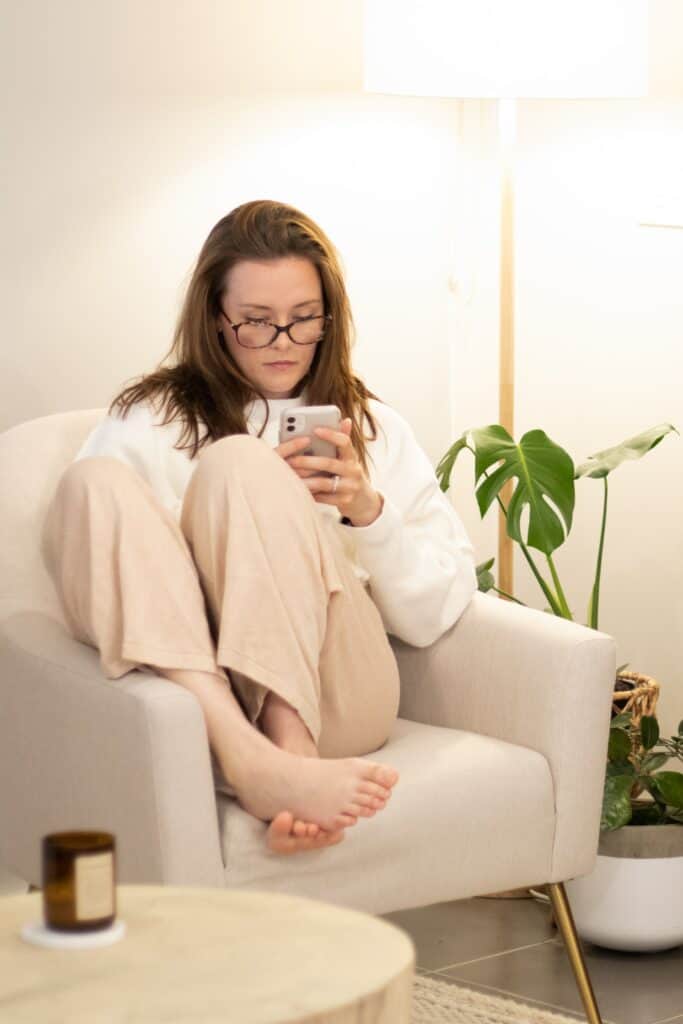
Digital minimalism uses technology to enhance our lives rather than clutter them. Below are some digital decluttering ideas.
- Delete inactive apps on your phone: We all have those apps that we never use but keep. If you’re not using an app, delete it. Or, if you want a little challenge, remove all third-party apps on your devices, including social media.
- Unsubscribe from unnecessary emails: If your inbox is full of unread emails, take a few minutes to unsubscribe from any emails that are no longer relevant to you (check out my guide on minimalist email).
- Delete old photos and videos: We all have those photos and videos that we never look at but can’t seem to delete. If you’re not looking at them, it’s time to let them go.
- Organise your files: A cluttered desktop can be frustrating and challenging to find what you’re looking for. Spend 30 minutes organising your files and trashing what you don’t need.
- Turn off notifications: We all have those notifications that we never seem to read. I’d argue that outside of messaging, notifications aren’t essential. Turn them off so you can enjoy fewer distractions.
- Delete excess alarms on your phone: Open up your clock and check to see how many active alarms you have going. Delete all but one or two so that you can start your day with a calm mind.
- Review how many digital services you’re subscribed to: We all have those digital services that we never use but keep paying for. If you’re not using a service, cancel it and save yourself some money.
Miscellaneous
You’ll likely find many miscellaneous items that don’t really have a place as you go through your house. Here are some ideas for what to do with them.
- Unused gift cards: You might find you have some gift cards that you never use but can’t seem to get rid of. If you’re not going to use them, give them to somebody that will.
- Old electronics: Electronics that we no longer need but can’t seem to let go of are scattered throughout the home. Recycle them so that they don’t end up in a landfill.
- Ruined pet toys: If you have pet toys that your furry friend has loved to death, it’s time to say goodbye.
- Old pet supplies: If your pet has passed away or has outgrown its bed, cage, toys or blanket, donate these items to your local animal sanctuary.
- Membership cards: You might have a drawer full of plastic cards that you never use but can’t seem to get rid of. If you’re not using them, cut them up.
- Inactive cleaning equipment: You had high hopes for that expensive carpet cleaner or portable vacuum, but unfortunately, you didn’t use them as much as you hoped. If they’re taking up space, see if you can sell them.
- Old key chains and lanyards: It’s random how many key chains and lanyards can be found throughout the house. Make it your mission to find all of them and dispose of them.
- Instruction manuals: If you still have the instruction manual for that old TV or computer, chances are you’re never going to need it. Besides, you can get most manuals online. Toss it out or recycle it.
- Unnecessary suitcases: While suitcases can double up as storage, they’re incredibly bulky and encourage you to store more things you don’t need. If you have broken, old or unused suitcases, get rid of them.
- Random party supplies: If you don’t see yourself using that box of one-time party supplies, eliminate them.
- Bumper stickers: If you have any bumper stickers that you no longer want on your car, they’re not serving a purpose, so peel them off and ditch them.
- Unused sewing, knitting and art supplies: When inactive or broken supplies pile up, it can be hard to find the motivation to continue crafting. Not only that, but clutter can also make it challenging to find the supplies you need when you want to start a new project. That’s why it’s important to regularly declutter your crafting tools and stationery. By getting rid of inactive or broken items, you can make room for new projects and ensure your workspace is always ready for inspiration.
Free printable decluttering checklist PDF
This is a mammoth post with a ton of information, so to make it easier for you, here’s a downloadable checklist for quick reference as you declutter your life.
What’s on your list?
I hope you found this decluttering checklist helpful. If you’re on your minimalist journey, I wish you all the best in your efforts to live with less.
What were some of the things you couldn’t believe you were hanging onto? Let me know in the comments below. If you found this post helpful, please share it with your friends. Thanks for reading!

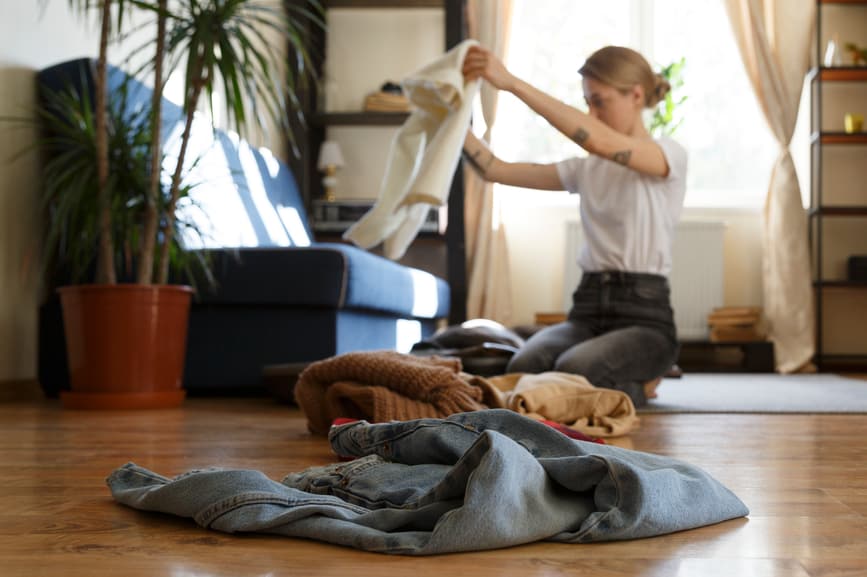
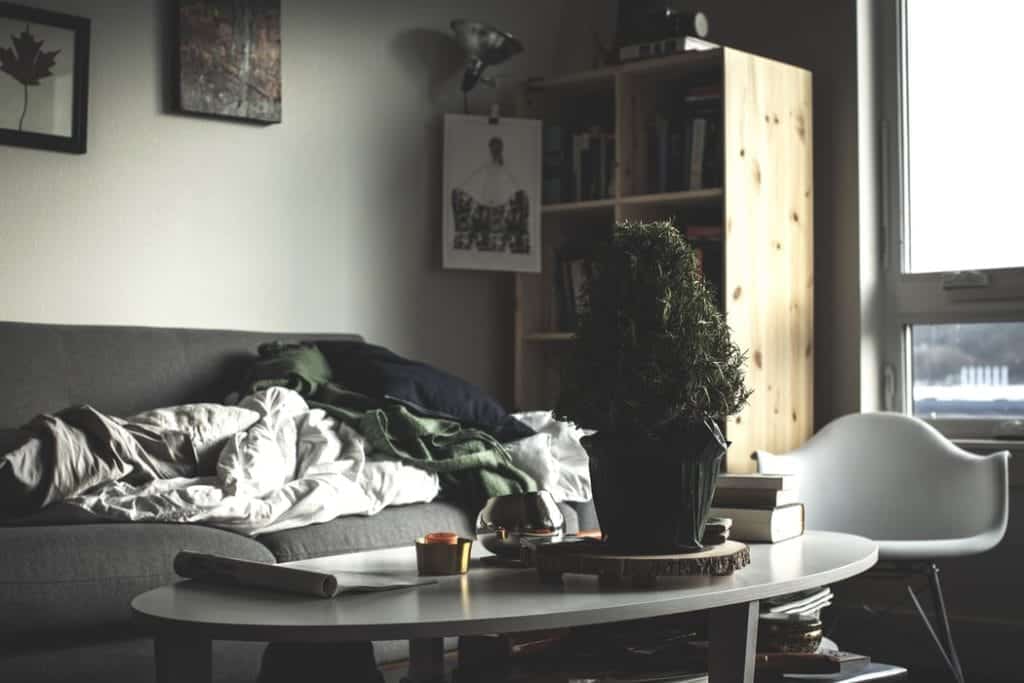
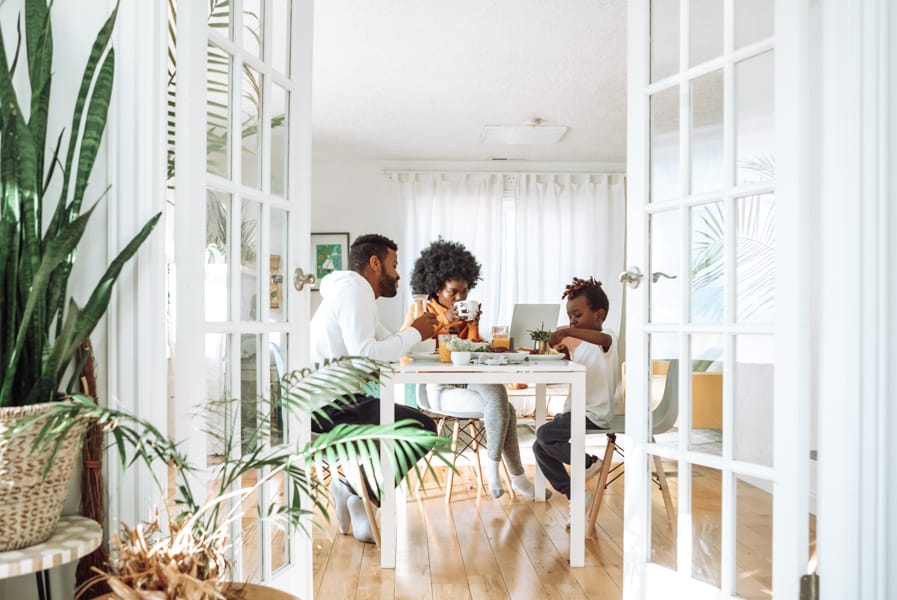
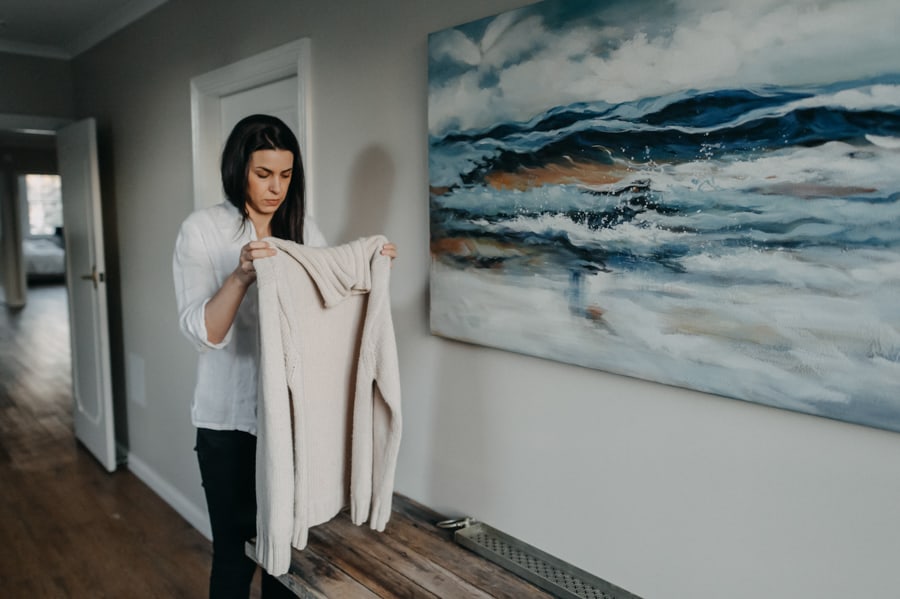
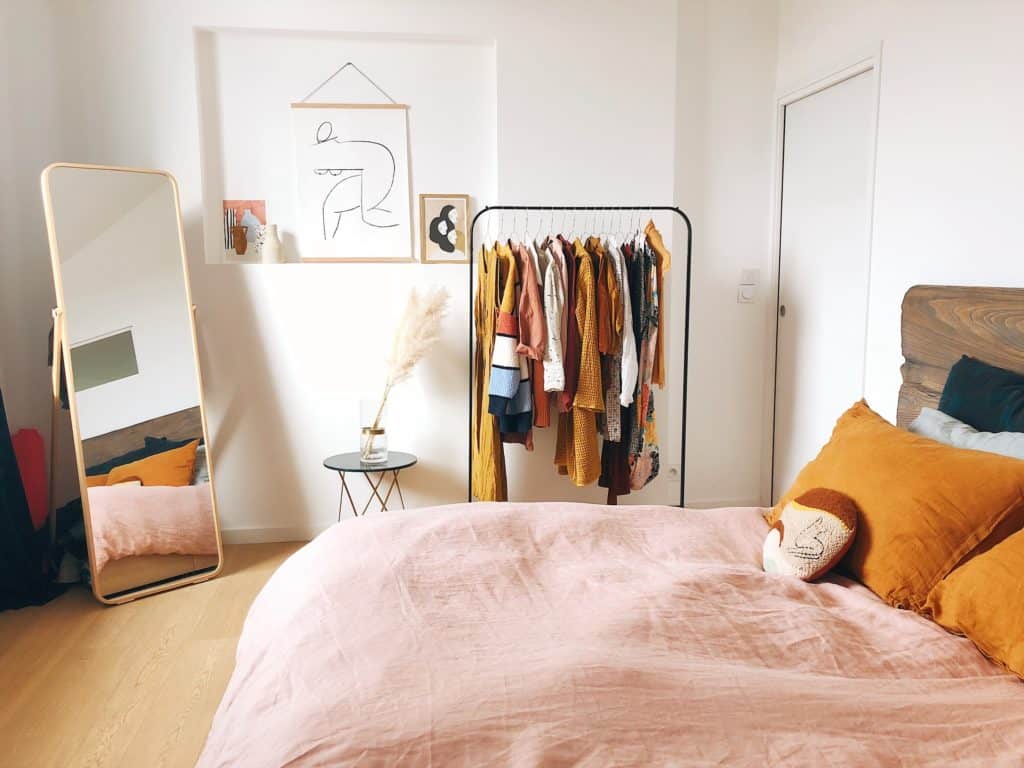
Such an incredible post. I really like it and enjoyed a lot to know about history. Thanks and keep sharing.
Always great to get a decluttering roadmap. Thank you!
Thanks Theresa! 🙂